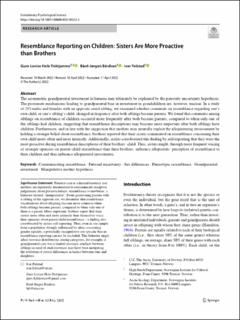| dc.contributor.author | Fisktjønmo, Guro Hole | |
| dc.contributor.author | Bårdsen, Bård-Jørgen | |
| dc.contributor.author | Folstad, Ivar | |
| dc.date.accessioned | 2022-06-07T10:27:06Z | |
| dc.date.available | 2022-06-07T10:27:06Z | |
| dc.date.created | 2022-05-05T14:38:10Z | |
| dc.date.issued | 2022 | |
| dc.identifier.issn | 2198-9885 | |
| dc.identifier.uri | https://hdl.handle.net/11250/2997659 | |
| dc.description.abstract | The asymmetric grandparental investment in humans may ultimately be explained by the paternity uncertainty hypothesis. The proximate mechanisms leading to grandparental bias in investment in grandchildren are, however, unclear. In a study of 233 males and females with an opposite sexed sibling, we examined whether comments on resemblance regarding one’s own child, or one’s sibling’s child, changed in frequency after both siblings became parents. We found that comments among siblings on resemblance of children occurred more frequently after both became parents, compared to when only one of the siblings had children, suggesting that resemblance descriptions may become more important after both siblings have children. Furthermore, and in line with the suggestion that mothers may mentally exploit the alloparenting environment by holding a stronger belief about resemblance, brothers reported that their sisters commented on resemblance concerning their own child more often and more intensely. Additionally, sisters corroborated this fnding by self-reporting that they were the most proactive during resemblance descriptions of their brothers’ child. Thus, sisters might, through more frequent voicing of stronger opinions on parent–child resemblance than their brothers, infuence alloparents’ perception of resemblance to their children and thus infuence alloparental investments. Communicating resemblance · Paternal uncertainty · Sex differences · Phenotypic resemblance · Grandparental investment · Manipulative mother hypothesis | |
| dc.language.iso | eng | |
| dc.title | Resemblance Reporting on Children: Sisters Are More Proactive than Brothers | |
| dc.title.alternative | Resemblance Reporting on Children: Sisters Are More Proactive than Brothers | |
| dc.type | Peer reviewed | |
| dc.type | Journal article | |
| dc.description.version | publishedVersion | |
| dc.subject.nsi | VDP::Psykologi: 260 | |
| dc.subject.nsi | VDP::Psychology: 260 | |
| dc.source.journal | Evolutionary Psychological Science | |
| dc.identifier.doi | 10.1007/s40806-022-00322-3 | |
| dc.identifier.cristin | 2021835 | |
| dc.relation.project | Egen institusjon: UiT The Arctic University of Norway | |
| dc.relation.project | Framsenteret: “Cooperative solutions to common problems” (369902) | |
| dc.relation.project | Nordforsk: Nordic Centre of Excellence (project number 76915) | |
| cristin.ispublished | true | |
| cristin.fulltext | original | |
| cristin.qualitycode | 1 | |
